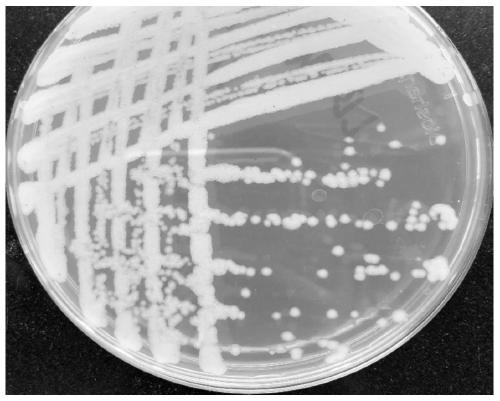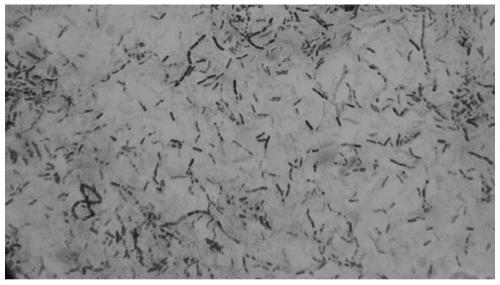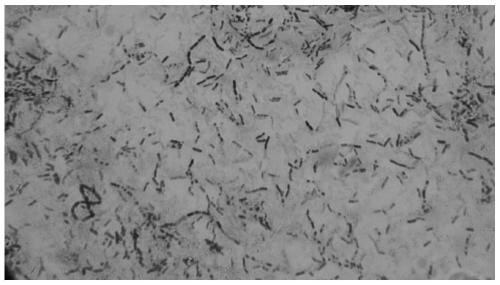Efficient calcium mineralizing bacterium and application thereof
A kind of mineralizing bacteria and high-efficiency technology, applied in the field of microorganisms, can solve the problems of destroying cultural relics, easily clogging stone cultural relics, permeability limitation, etc., and achieve the effect of strong calcium mineralization performance
- Summary
- Abstract
- Description
- Claims
- Application Information
AI Technical Summary
Problems solved by technology
Method used
Image
Examples
Embodiment 1
[0017] The strain is isolated from EM strains, and the specific method is as follows: add 1 g of EM strains to 9 mL of sterile water, oscillate and shake well, and gradiently dilute to 10 -1 、10 -2 、10 -3 、10 -4 、10 -5 、10 -6 A total of 6 concentrations, spread the dilution on the MRS plate (MRS solid medium composition: K 2 HPO 4 2.0g / L, MgSO 4 ·7H 2 O 0.2g / L, FeSO 4 •7H 2 O 0.03g / L, ammonium citrate 2.0 g / L, sodium acetate 5.0 g / L, glucose 20.0 g / L, peptone 4.0 g / L, beef extract 4.0 g / L, yeast extract 2.0 g / L, agar 20 g / L, pH=6.5-7.0), incubate at 30°C for 2-3 days, until colonies grow out, pick colonies of different shapes and streak them on fresh MRS medium for 3 times to obtain pure bacteria. The obtained strains were inoculated into MRS liquid medium, and cultured on a shaker at 30°C and 180 r / min for 24 hours. The culture medium was mixed with 80 wt.% glycerol 1:1, and stored in a -80°C refrigerator.
Embodiment 2
[0019] Amplification and sequencing primers:
[0020] Forward primer: 27F 5'-AGAGTTTGATCCTGGCTCAG-3'
[0021] Reverse primer: 1492R 5'-GGTTACCTTGTTACGACTT-3'
[0022] The total DNA of the EMCa1 strain was extracted, and the 16s rDNA gene of the strain was amplified by PCR with primers 27F and 1492R, and sequenced with primers 27F and 1492R. The 16s rDNA gene sequence of the strain is shown in Seq ID No:1.
[0023] On http: / / blast.ncbi.nlm.nih.gov / Blast.cgi, the 16srDNA gene sequence of EMCa1 was compared with the known sequence of GenBank with BLAST software. The results showed that the sequence homology between the strain EMCa1 and the 16S rDNA gene (Bacillus cereus strain C5 16S ribosomal RNA gene, partial sequence) of Bacillus cereus C5 reached 100%, which proved that the strain EMCa1 belonged to the genus Bacillus cereus.
Embodiment 3
[0025] Add 20 g / L coral sand to 100 mL MRS medium, sterilize at 115°C for 30 minutes, and inoculate the strain EMCa1 at a ratio of 1%, and use the medium without bacteria as a control, at 30°C, After culturing on a shaker at 180 r / min for 20 days, the supernatant was taken to measure the concentration of calcium ions in the solution with an inductively coupled plasma emission spectrometer, and the coral sand was taken out to dry and analyzed by XRD with an X-ray diffractometer. Results The concentration of calcium ions in the control solution without bacteria was 36.9 mg / L, and the proportion of calcite in coral sand was 2%, while the treatment with EMCa1, the concentration of calcium ions in the solution was 7.19 mg / L, and the proportion of calcite in coral sand was 7.19 mg / L. The ratio is 20%. It can be seen that the strain EMCa1 converts calcium ions in the solution into calcium carbonate.
[0026] With the same method, after inserting other bacterial strains at the same ti...
PUM
 Login to View More
Login to View More Abstract
Description
Claims
Application Information
 Login to View More
Login to View More - R&D
- Intellectual Property
- Life Sciences
- Materials
- Tech Scout
- Unparalleled Data Quality
- Higher Quality Content
- 60% Fewer Hallucinations
Browse by: Latest US Patents, China's latest patents, Technical Efficacy Thesaurus, Application Domain, Technology Topic, Popular Technical Reports.
© 2025 PatSnap. All rights reserved.Legal|Privacy policy|Modern Slavery Act Transparency Statement|Sitemap|About US| Contact US: help@patsnap.com



